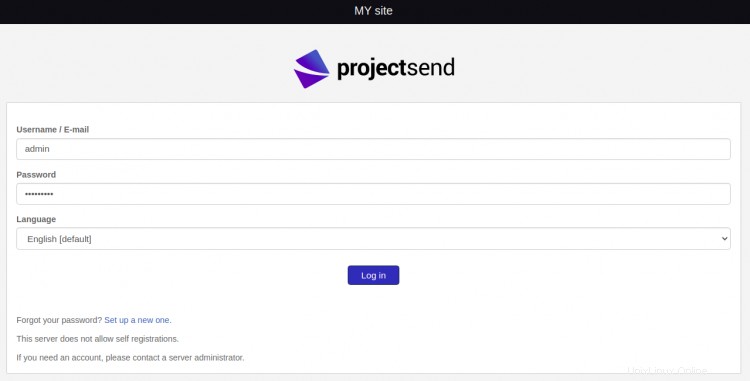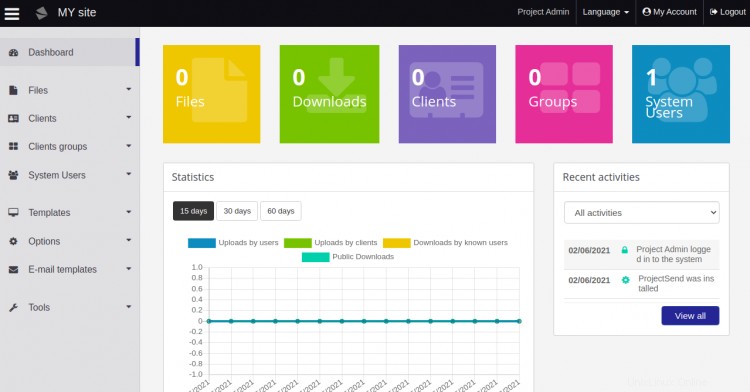ProjectSend es una aplicación gratuita y de código abierto para compartir archivos e imágenes que le ayuda a compartir archivos entre su empresa y sus clientes. Es una herramienta para compartir archivos orientada al cliente que le permite cargar y compartir archivos de tamaño ilimitado en cualquier servidor. Está escrito en PHP y utiliza una base de datos MySQL para almacenar la información. Ofrece un amplio conjunto de características que incluyen estadísticas en tiempo real, registro automático, inicio de sesión automático, plantillas de correo electrónico personalizadas y más.
En esta publicación, le mostraremos cómo instalar la aplicación para compartir archivos ProjectSend con Apache y Let's Encrypt SSL en Ubuntu 20.04.
Requisitos
- Un servidor con Ubuntu 20.04.
- Un nombre de dominio válido apuntado con la IP de su servidor.
- Se configura una contraseña raíz en el servidor.
Cómo empezar
Primero, actualice los paquetes del sistema a la versión actualizada ejecutando el siguiente comando:
apt-get update -y
Una vez que todos los paquetes estén actualizados, puede continuar con el siguiente paso.
Instalar servidor LAMP
Primero, deberá instalar Apache, MariaDB, PHP y otras extensiones requeridas en su servidor. Puede instalarlos todos con el siguiente comando:
apt-get install apache2 mariadb-server imagemagick php libapache2-mod-php php-imagick php7.4-common php7.4-mysql php7.4-gd php7.4-json php7.4-curl php7.4-zip php7.4-xml php7.4-mbstring php7.4-bz2 php7.4-intl php7.4-bcmath php7.4-gmp
Después de instalar todos los paquetes, edite el archivo php.ini:
nano /etc/php/7.4/apache2/php.ini
Cambie las siguientes configuraciones:
memory_limit = 512M upload_max_filesize = 32M max_execution_time = 300 date.timezone = Asia/Kolkata
Guarde y cierre el archivo, luego reinicie el servicio Apache para aplicar los cambios:
systemctl restart apache2
Una vez que haya terminado, puede continuar con el siguiente paso.
Crear una base de datos para ProjectSend
A continuación, deberá crear una base de datos y un usuario para ProjectSend.
Para hacerlo, inicie sesión en MariaDB con el siguiente comando:
mysql
Una vez que inicie sesión, cree una base de datos y un usuario con el siguiente comando:
MariaDB [(none)]> create database projectsend;
MariaDB [(none)]> create user [email protected] identified by 'password';
A continuación, otorgue todos los privilegios a la base de datos de proyectos con el siguiente comando:
MariaDB [(none)]> grant all privileges on projectsend.* to [email protected];
A continuación, elimine los privilegios y salga de MariaDB con el siguiente comando:
MariaDB [(none)]> flush privileges;
MariaDB [(none)]> exit;
Una vez que haya terminado, puede continuar con el siguiente paso.
Descargar ProjectSend
A continuación, deberá descargar la última versión de ProjectSend desde su sitio web oficial. Puedes descargarlo con el siguiente comando:
wget -O projectsend.zip https://www.projectsend.org/download/387/
Una vez que se complete la descarga, extraiga el archivo descargado con el siguiente comando:
unzip projectsend.zip -d /var/www/html/projectsend
A continuación, cambie el directorio al directorio extraído y cambie el nombre del archivo de configuración predeterminado:
cd /var/www/html/projectsend/includes
cp sys.config.sample.php sys.config.php
A continuación, edite el archivo de configuración con el siguiente comando:
nano sys.config.php
Cambie las siguientes configuraciones:
define('DB_DRIVER', 'mysql');
/** Database name */
define('DB_NAME', 'projectsend');
/** Database host (in most cases it's localhost) */
define('DB_HOST', 'localhost');
/** Database username (must be assigned to the database) */
define('DB_USER', 'projectsend');
/** Database password */
define('DB_PASSWORD', 'password');
Guarde y cierre el archivo, luego establezca el permiso y la propiedad adecuados con el siguiente comando:
chown -R www-data:www-data /var/www/html/projectsend
chmod -R 775 /var/www/html/projectsend
chmod 644 /var/www/html/projectsend/includes/sys.config.php
Una vez que haya terminado, puede continuar con el siguiente paso.
Configurar Apache para ProjectSend
A continuación, cree un archivo de configuración de host virtual apache con el siguiente comando:
nano /etc/apache2/sites-available/projectsend.conf
Agregue las siguientes líneas:
<VirtualHost *:80> ServerAdmin [email protected] DocumentRoot /var/www/html/projectsend/ ServerName projectsend.example.com <Directory /var/www/html/projectsend/> Options FollowSymLinks AllowOverride All Order allow,deny allow from all </Directory> ErrorLog /var/log/apache2/example.com-error_log CustomLog /var/log/apache2/example.com-access_log common </VirtualHost>
Guarde y cierre el archivo, luego habilite el módulo de reescritura y el archivo de configuración del host virtual con el siguiente comando:
a2enmod rewrite
a2ensite projectsend.conf
A continuación, reinicie el servicio Apache para aplicar los cambios:
systemctl restart apache2
Ahora puede comprobar el estado de Apache con el siguiente comando:
systemctl status apache2
Debería ver el siguiente resultado:
? apache2.service - The Apache HTTP Server
Loaded: loaded (/lib/systemd/system/apache2.service; enabled; vendor preset: enabled)
Active: active (running) since Wed 2021-06-02 07:11:08 UTC; 5min ago
Docs: https://httpd.apache.org/docs/2.4/
Process: 17680 ExecReload=/usr/sbin/apachectl graceful (code=exited, status=0/SUCCESS)
Main PID: 14862 (apache2)
Tasks: 6 (limit: 2353)
Memory: 25.0M
CGroup: /system.slice/apache2.service
??14862 /usr/sbin/apache2 -k start
??17684 /usr/sbin/apache2 -k start
??17685 /usr/sbin/apache2 -k start
??17686 /usr/sbin/apache2 -k start
??17687 /usr/sbin/apache2 -k start
??17688 /usr/sbin/apache2 -k start
Jun 02 07:11:08 ubuntu2004 systemd[1]: Starting The Apache HTTP Server...
Acceder a la interfaz web de ProjectSend
Ahora, abra su navegador web y acceda a la interfaz web de ProjectSend usando la URL http://projectsend.example.com . Debería ver la siguiente página:

Proporcione el nombre de su sitio, la URL del sitio, el nombre de usuario del administrador, la contraseña y haga clic en Instalar botón. Debería ver la siguiente página:

Ahora, haga clic en Iniciar sesión botón. Debería ver la siguiente página:

Proporcione su nombre de usuario y contraseña de administrador y haga clic en Iniciar sesión botón. Debería ver el panel de control de ProjectSend en la siguiente página:

Asegure ProjectSend con Let's Encrypt SSL
Siempre es una buena idea proteger su sitio web con Let's Encrypt SSL. Primero, deberá instalar el cliente Certbot para instalar y administrar SSL. De forma predeterminada, el paquete Certbot se incluye en el repositorio predeterminado de Ubuntu para que pueda instalarlo con el siguiente comando:
apt-get install python3-certbot-apache -y
Una vez que Certbot esté instalado, ejecute el siguiente comando para proteger su sitio web con Let's Encrypt SSL:
certbot --apache -d projectsend.example.com
Se le pedirá que proporcione su correo electrónico y acepte el término del servicio como se muestra a continuación:
Saving debug log to /var/log/letsencrypt/letsencrypt.log Plugins selected: Authenticator standalone, Installer None Enter email address (used for urgent renewal and security notices) (Enter 'c' to cancel): [email protected] - - - - - - - - - - - - - - - - - - - - - - - - - - - - - - - - - - - - - - - - Please read the Terms of Service at https://letsencrypt.org/documents/LE-SA-v1.2-November-15-2017.pdf. You must agree in order to register with the ACME server at https://acme-v02.api.letsencrypt.org/directory - - - - - - - - - - - - - - - - - - - - - - - - - - - - - - - - - - - - - - - - (A)gree/(C)ancel: A - - - - - - - - - - - - - - - - - - - - - - - - - - - - - - - - - - - - - - - - Would you be willing to share your email address with the Electronic Frontier Foundation, a founding partner of the Let's Encrypt project and the non-profit organization that develops Certbot? We'd like to send you email about our work encrypting the web, EFF news, campaigns, and ways to support digital freedom. - - - - - - - - - - - - - - - - - - - - - - - - - - - - - - - - - - - - - - - - (Y)es/(N)o: Y Plugins selected: Authenticator apache, Installer apache Obtaining a new certificate Performing the following challenges: http-01 challenge for projectsend.example.com Enabled Apache rewrite module Waiting for verification... Cleaning up challenges Created an SSL vhost at /etc/apache2/sites-available/projectsend-le-ssl.conf Enabled Apache socache_shmcb module Enabled Apache ssl module Deploying Certificate to VirtualHost /etc/apache2/sites-available/projectsend-le-ssl.conf Enabling available site: /etc/apache2/sites-available/projectsend-le-ssl.conf
A continuación, seleccione si desea redirigir o no el tráfico HTTP a HTTPS como se muestra a continuación:
Please choose whether or not to redirect HTTP traffic to HTTPS, removing HTTP access. - - - - - - - - - - - - - - - - - - - - - - - - - - - - - - - - - - - - - - - - 1: No redirect - Make no further changes to the webserver configuration. 2: Redirect - Make all requests redirect to secure HTTPS access. Choose this for new sites, or if you're confident your site works on HTTPS. You can undo this change by editing your web server's configuration. - - - - - - - - - - - - - - - - - - - - - - - - - - - - - - - - - - - - - - - - Select the appropriate number [1-2] then [enter] (press 'c' to cancel): 2
Escriba 2 y presione Entrar para instalar Let's Encrypt SSL para su sitio web:
Enabled Apache rewrite module Redirecting vhost in /etc/apache2/sites-enabled/projectsend.conf to ssl vhost in /etc/apache2/sites-available/projectsend-le-ssl.conf - - - - - - - - - - - - - - - - - - - - - - - - - - - - - - - - - - - - - - - - Congratulations! You have successfully enabled https://projectsend.example.com You should test your configuration at: https://www.ssllabs.com/ssltest/analyze.html?d=projectsend.example.com - - - - - - - - - - - - - - - - - - - - - - - - - - - - - - - - - - - - - - - - IMPORTANT NOTES: - Congratulations! Your certificate and chain have been saved at: /etc/letsencrypt/live/projectsend.example.com/fullchain.pem Your key file has been saved at: /etc/letsencrypt/live/projectsend.example.com/privkey.pem Your cert will expire on 2021-12-23. To obtain a new or tweaked version of this certificate in the future, simply run certbot again with the "certonly" option. To non-interactively renew *all* of your certificates, run "certbot renew" - If you like Certbot, please consider supporting our work by: Donating to ISRG / Let's Encrypt: https://letsencrypt.org/donate Donating to EFF: https://eff.org/donate-le
Conclusión
¡Felicidades! Ha instalado correctamente ProjectSend con Apache y Let's Encrypt SSL en Ubuntu 20.04. Ahora puede compartir fácilmente archivos e imágenes desde la interfaz web de ProjectSend.